Overview
Since assuming the throne from his late father on February 7, 1999, Jordan's 56-year-old monarch King Abdullah II bin Al Hussein (hereinafter King Abdullah II) has maintained Jordan's stability and strong ties to the United States. Although many commentators frequently caution that Jordan's stability is fragile, the monarchy has remained resilient owing to a number of factors. These include a relatively strong sense of social cohesion, strong support for the government from both Western powers and the Gulf Arab monarchies, and an internal security apparatus that is highly capable and, according to human rights groups, uses vague and broad criminal provisions in the legal system to dissuade dissent.1
U.S. officials frequently express their support for Jordan. President Trump has acknowledged Jordan's role as a key U.S. partner in countering the Islamic State, as U.S. policymakers advocate for continued robust U.S. assistance to the kingdom. Annual aid to Jordan has nearly quadrupled in historical terms over the last 15 years. Jordan also hosts thousands of U.S. troops. According to President Trump's June 2018 War Powers Resolution Report to Congress, "At the request of the Government of Jordan, approximately 2,600 United States military personnel are deployed to Jordan to support Defeat-ISIS operations, to enhance Jordan's security, and to promote regional stability."2
Country Background
Although the United States and Jordan have never been linked by a formal treaty, they have cooperated on a number of regional and international issues for decades. Jordan's small size and lack of major economic resources have made it dependent on aid from Western and various Arab sources. U.S. support, in particular, has helped Jordan deal with serious vulnerabilities, both internal and external. Jordan's geographic position, wedged between Israel, Syria, Iraq, and Saudi Arabia, has made it vulnerable to the strategic designs of its powerful neighbors, but has also given Jordan an important role as a buffer between these countries in their largely adversarial relations with one another.
Jordan, created by colonial powers after World War I, initially consisted of desert or semidesert territory east of the Jordan River, inhabited largely by people of Bedouin tribal background. The establishment of the state of Israel in 1948 brought large numbers of Palestinian refugees to Jordan, which subsequently unilaterally annexed a Palestinian enclave west of the Jordan River known as the West Bank.3 The original "East Bank" Jordanians, though probably no longer a majority in Jordan, remain predominant in the country's political and military establishments and form the bedrock of support for the Jordanian monarchy. Jordanians of Palestinian origin comprise an estimated 55% to 70% of the population and generally tend to gravitate toward the private sector due to their general exclusion from certain public-sector and military positions.4
The Hashemite Royal Family
Jordan is a hereditary constitutional monarchy under the prestigious Hashemite family, which claims descent from the Prophet Muhammad. King Abdullah II (age 56) has ruled the country since 1999, when he succeeded to the throne upon the death of his father, the late King Hussein, after a 47-year reign. Educated largely in Britain and the United States, King Abdullah II had earlier pursued a military career, ultimately serving as commander of Jordan's Special Operations Forces with the rank of major general. The king's son, Prince Hussein bin Abdullah (born in 1994), is the designated crown prince.5
The king appoints a prime minister to head the government and the Council of Ministers (cabinet). On average, Jordanian governments last no more than 15 months before they are dissolved by royal decree. This seems to be done in order to bolster the king's reform credentials and to distribute patronage among a wide range of elites. The king also appoints all judges and is commander of the armed forces.
Political System and Key Institutions
The Jordanian constitution, most recently amended in 2016, empowers the king with broad executive powers. The king appoints the prime minister and may dismiss him or accept his resignation. He also has the sole power to appoint the crown prince, senior military leaders, justices of the constitutional court, and all 75 members of the senate. The king appoints cabinet ministers. The constitution enables the king to dissolve both houses of parliament and postpone lower house elections for two years.6 The king can circumvent parliament through a constitutional mechanism that allows provisional legislation to be issued by the cabinet when parliament is not sitting or has been dissolved.7 The king also must approve laws before they can take effect, although a two-thirds majority of both houses of parliament can modify legislation. The king also can issue royal decrees, which are not subject to parliamentary scrutiny. The king commands the armed forces, declares war, and ratifies treaties. Finally, Article 195 of the Jordanian Penal Code prohibits insulting the dignity of the king (lèse-majesté), with criminal penalties of one to three years in prison.
Jordan's constitution provides for an independent judiciary. According to Article 97, "Judges are independent, and in the exercise of their judicial functions they are subject to no authority other than that of the law." Jordan has three main types of courts: civil courts, special courts (some of which are military/state security courts), and religious courts. In Jordan, state security courts administered by military (and civilian) judges handle criminal cases involving espionage, bribery of public officials, trafficking in narcotics or weapons, black marketeering, and "security offenses." Overall, the king may appoint and dismiss judges by decree, though in practice a palace-appointed Higher Judicial Council manages court appointments, promotions, transfers, and retirements.
Although King Abdullah II has envisioned Jordan's gradual transition from a constitutional monarchy into a full-fledged parliamentary democracy,8 in reality, successive Jordanian parliaments have mostly complied with the policies laid out by the Royal Court. The legislative branch's independence has been curtailed not only by a legal system that rests authority largely in the hands of the monarch, but also by carefully crafted electoral laws designed to produce propalace majorities with each new election.9 Due to frequent gerrymandering in which electoral districts are drawn to favor more rural progovernment constituencies over densely populated urban areas, parliamentary elections have produced large progovernment majorities dominated by representatives of prominent tribal families. In addition, voter turnout tends to be much higher in progovernment areas since many East Bank Jordanians depend on family/tribal connections as a means to access patronage jobs.
Short-Term Outlook
In late 2018, the outlook for the Hashemite Kingdom of Jordan, a vital U.S. partner in the Middle East, is mixed. On the one hand, as conflicts in Syria and Iraq have abated somewhat, the kingdom faces improved prospects for stable borders, a resumption of trade with its neighbors, and the possible repatriation of hundreds of thousands of refugees. On the other hand, continuing economic discontent and sensitivity among the public regarding recent U.S. policy changes on Israel and the Palestinians have placed Jordan in a difficult political position.
Public dissatisfaction with the economy is probably the most pressing concern for the monarchy. Over the summer of 2018, widespread protests erupted throughout the kingdom in opposition to a draft tax bill and price hikes on fuel and electricity. Though peaceful, the protests drew immediate international attention because of their scale. Since summer, the government has continued to work with the International Monetary Fund (IMF) on fiscal reforms to address a public debt that has ballooned to 96.4% of Gross Domestic Product (GDP).
As the Trump Administration has enacted changes to long-standing U.S. policies on Israel and the Palestinians, which have been perceived by the Palestinians to be unfairly punitive and biased toward Israel, Jordan has been placed in a difficult political position. While King Abdullah II seeks to maintain strong relations with the United States, he rules over a country where the issue of Palestinian rights resonates with much of the Jordanian population; it is estimated that more than half of all Jordanian citizens originate from either the West Bank or the area now comprising the state of Israel. In trying to balance U.S.-Jordanian relations with concern for Palestinian rights, King Abdullah II has refrained from directly criticizing the Trump Administration on its recent moves, while urging the international community to return to the goal of a two-state solution that would ultimately lead to an independent Palestinian state with East Jerusalem as its capital.10
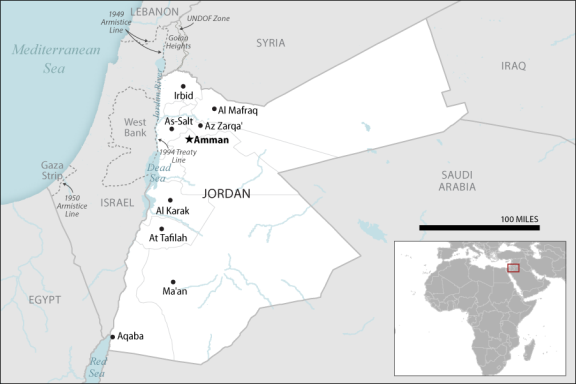 |
|
Area: 89,213 sq. km. (34,445 sq. mi., slightly smaller than Indiana) Population: 8,185,384 (2016); Amman (capital): 1.155 million (2015) Ethnic Groups: Arabs 98%; Circassians 1%; Armenians 1% Religion: Sunni Muslim 97.2%; Christian 2% Percent of Population Under Age 25: 55% (2016) Literacy: 95.4% (2015) Youth Unemployment: 29.3% (2012) |
Source: Graphic created by CRS; facts from CIA World Factbook.
The Economy
With few natural resources and a small industrial base, Jordan has an economy that depends heavily on external aid, tourism, expatriate worker remittances, and the service sector. Among the long-standing problems Jordan faces are poverty, corruption, slow economic growth, and high levels of unemployment. The government is by far the largest employer, with between one-third and two-thirds of all workers on the state's payroll. These public sector jobs, along with government-subsidized food and fuel, have long been part of the Jordanian government's "social contract" with its citizens.
In the past decade, this arrangement between state and citizen has become more strained. When oil prices skyrocketed between 2007 and 2008, the government had to increase its borrowing in order to continue fuel subsidies. The 2008 global financial crisis was another shock to Jordan's economic system, as it depressed worker remittances from expatriates. The unrest that spread across the region in 2011 further exacerbated Jordan's economic woes, as the influx of hundreds of thousands Syrian refugees increased demand for state services and resources. Moreover, tourist activity, trade, and foreign investment decreased in Jordan after 2011 due to regional instability.
Finally, Jordan, like many other countries, has experienced uneven economic growth, with higher growth in the urban core of the capital Amman and stagnation in the historically poorer and more rural areas of southern Jordan. According to the Economist Intelligence Unit, Amman is the most expensive Arab city to live in.11
Popular economic grievances have spurred the most vociferous protests in Jordan. Youth unemployment is high, as it is elsewhere in the Middle East, and providing better economic opportunities for younger Jordanians outside of Amman is a major challenge. Large-scale agriculture is not sustainable because of water shortages, so government officials are generally left providing young workers with low-wage, relatively unproductive civil service jobs. How the Jordanian education system and economy can respond to the needs of its youth has been and will continue to be one of the defining domestic challenges for the kingdom in the years ahead.
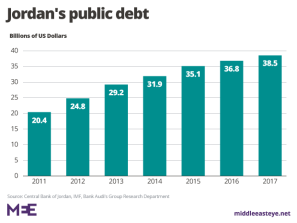 |
|
Source: Middle East Eye |
In 2016, the IMF and Jordan reached a three-year, $723 million extended fund facility (EFF) agreement that commits Jordan to improving the business environment for the private sector, reducing budget expenditures, and reforming the tax code. As a result, in 2017 Jordan enacted a Value Added Tax (VAT) on common goods to raise revenue. The government also is in the process of eliminating popular subsidies on critical commodities such as flour.
To comply with IMF-mandated reforms, the Jordanian government drafted a new tax bill to increase personal income taxes and thus raise government revenue and ease the public debt burden (see Figure 2). The draft tax bill would have lowered the minimum taxable income in order to expand the tax base from 4.5% of workers to 10%.12 It also would have raised corporate taxes on banks and reclassified tax evasion as a felony rather than a misdemeanor.
In late May 2018, as the bill drew closer to passage and after an IMF team visited Jordan to review its economic reform plan, demonstrations began across the country. On May 30, Jordanian unions and professional associations held a massive general strike against the tax bill and were joined by many younger protesters who denounced recent price hikes on fuel and electricity. Days later, King Abdullah II ordered the government to freeze a 5.5% increase in the price of fuel and a 19% increase in electricity prices. For days, protests continued throughout the country, with some protesters calling for parliament to be dissolved and the political system to be reformed.
On June 4, Prime Minister Hani Mulki resigned, and King Abdullah II appointed Education Minister and former World Bank economist Omar Razzaz as prime minister. A change in prime minister is considered fairly routine in Jordanian politics, and protesters decried it as an insufficient response to their demands. Large-scale demonstrations continued for two more days, and on June 7 the government announced that it was withdrawing the bill from immediate consideration and sending it back to parliament for revision.
On June 11, Kuwait, the United Arab Emirates, and Saudi Arabia held a summit in Mecca, Saudi Arabia, where they collectively pledged $2.5 billion for Jordan. The aid includes a deposit at the Central Bank of Jordan. The IMF also is supporting the Jordanian government's decision to revise the tax bill, noting that fiscal reforms should not come at the expense of political stability.13
This was not the first time that the Jordanian monarchy backtracked on reforms in the face of public pressure. In 1989, 1996, and 2012, Jordanian monarchs responded to mass demonstrations with limited political reforms (new elections and electoral laws, constitutional amendments, anticorruption measures) that did not fundamentally alter the political system. In times of crisis, the government often appeals for Jordanian unity, while calling the opposition divisive or even disloyal.14 King Abdullah II's turn toward the Gulf for a financial bailout also has precedents. In 2012, at the height of unrest in the Middle East, the Gulf Cooperation Council countries pledged $5 billion to Jordan.
While the government has used familiar tools in its response to protests, the protesters themselves do not necessarily fit the profile of previous demonstrations. This year's demonstrations were not organized by Islamists or pro-Palestinian activists focusing primarily on political grievances, but were decentralized and focused mainly on economic themes.15 Many protesters hailed from traditional strongholds of the monarchy, calling into question how King Abdullah II will be able to manage in the future if he is pressured to enact fiscal austerity measures.
In fall 2018, the Jordanian government proposed a new draft tax bill which raises personal and family exemptions for the poorest citizens. The Gulf monarchies also followed through with their $2.5 billion pledge to Jordan, providing $1 billion in central bank deposits, $600 million in loan guarantees, $750 million in direct budgetary support (spread over five years), and $150 million for school construction.16
The War in Syria and Its Impact on Jordan
Throughout Syria's civil war, Jordan has prioritized stability on its northern border and has worked with select Syrian rebel groups, the Asad regime, Israel, the United States, and—since its intervention in 2015— the Russian government, in ways intended to shield the kingdom from the war's fallout. In 2017, the United States, Russia, and Jordan agreed to a de-escalation zone along the Jordanian-Syrian border in order to reduce fighting and ensure that no Iranian-backed militias would be based near Jordan or Israel.
In summer 2018, Syrian military forces recaptured southwest Syria. Since then, the Syrian and Jordanian governments have engaged in talks about opening border crossings to allow for a resumption in bilateral trade and the possible return of Syrian refugees residing in Jordan.17 The kingdom had wanted to ensure that before Syria and Jordan fully normalize relations and reopen borders, the two sides work out a process for legally dealing with Jordanian fighters who traveled to Syria and Iraq.18 On October 15, 2018, Syria and Jordan reopened the Nassib border crossing to people and goods with the Jordanian government noting that Syrians entering Jordan must first obtain the necessary clearance.19
|
Islamic State (IS) Sympathizers Kill Four Security Personnel in Jordan In August 2018, IS sympathizers placed an improvised explosive device (IED) under a police vehicle which was stationed at a music festival in a predominately Christian area in the town of Fuheis. The IED remotely detonated, killing one officer. In the process of searching for the perpetrators of the attack, security forces laid siege to their hideout in a residential area of the town of Salt. In an exchange of fire that killed three militants, three more Jordanian personnel were killed. Several other suspects were arrested. This incident was the first terrorist attack inside Jordan since December 2016. According to one analysis, "Returning Jordanian jihadists with operational experience in Syria and Iraq are bringing with them IED and tactical expertise, and the attack shows increased bomb-making capabilities."20 |
Syrian Refugees in Jordan
Since 2011, the influx of Syrian refugees has placed tremendous strain on Jordan's government and local economies, especially in the northern governorates of Mafraq, Irbid, Ar Ramtha, and Zarqa. As of October 2018, the United Nations High Commissioner for Refugees (UNHCR) estimates that there are 671,919 registered Syrian refugees in Jordan; 83% of all Syrian refugees live in urban areas, while the remaining 17% live in three camps—Azraq, Zaatari, and the Emirati Jordanian Camp (Mrajeeb al Fhood). Due to Jordan's small population size, it has one of the highest per capita refugee rates in the world.
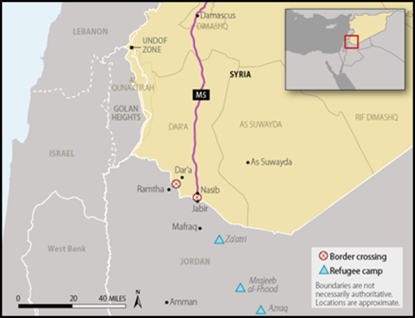 |
|
Source: CRS Graphics. Note: M5 (purple line) is the main north-south highway in Syria. |
Another 45,000 refugees are stranded in the desert along the northeastern Jordanian area bordering Syria and Iraq, known as Rukban. Though most of the refugees stranded at Rukban are women and children, a June 2016 IS terrorist attack near the border led Jordanian authorities to close the area, and access to Rukban is sporadic. In fall 2018, Syrian regime forces prevented food from entering the area from the Syrian side, eventually permitting a United Nations aid food delivery on October 17, 2018. According to one report, Rukban is located within a 35-mile, U.S. established "de-confliction zone" surrounding U.S. forces based at the Tanf garrison near the Syrian-Iraqi-Jordanian triborder area.21
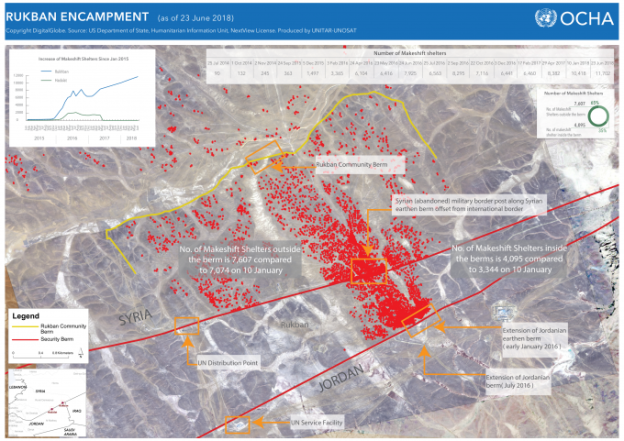 |
|
Source: U.N. Office for the Coordination of Humanitarian Affairs. |
Israel, the Palestinians, and U.S. Policy
The Jordanian government has long described efforts to secure a lasting end to the Israeli-Palestinian conflict as one of its highest priorities. In 1994, Jordan and Israel signed a peace treaty,22 and King Abdullah II has used his country's relationship with Israel to improve Jordan's standing with Western governments and international financial institutions, on which it relies heavily for external support and aid. Nevertheless, the persistence of Israeli-Palestinian conflict continues to be a major challenge for Jordan. The issue of Palestinian rights resonates with much of the population; it is estimated that more than half of all Jordanian citizens originate from either the West Bank or the area now comprising the state of Israel.23
|
Holy Sites in Jerusalem24 Per arrangements with Israel dating back to 1967 and then subsequently confirmed in their 1994 bilateral peace treaty, Israel acknowledges a continuing role for Jordan vis-à-vis Jerusalem's historic Muslim shrines.25 A Jordanian waqf (or Islamic custodial trust) has long administered the Temple Mount (known by Muslims as the Haram al Sharif or Noble Sanctuary) and its holy sites, and this role is key to bolstering the religious legitimacy of the Jordanian royal family's rule. Successive Jordanian monarchs trace their lineage to the Prophet Muhammad. Disputes over Jerusalem that appear to circumscribe King Abdullah II's role as guardian of the Islamic holy sites create a domestic political problem for the King. Jewish worship on the Mount/Haram is prohibited under a long-standing "status quo" arrangement. |
Since December 2017, when the Palestinians broke off high-level political contacts with the United States after President Trump's decision to recognize Jerusalem as Israel's capital and relocate the U.S. embassy there, Jordan has been caught in the middle of ongoing acrimony between the Trump Administration and the Palestinian Authority. Jordan has expressed solidarity with the Palestinians while also trying to encourage the Trump Administration to commit to the two-state solution. In a recent interview with Fox News, King Abdullah II said the following:
The President [Trump] from day one was committed to a fair and balanced deal for the Israelis and Palestinians to move the process forward. We're not too sure what the plan is, that's part of the problem, so it's more difficult for us to be able to step in and help. What I'm worried about is that we will go from the two state solution to a one state solution, which is a disaster for all of us in the region, including Israel. If most of the final status issues are being taken off the table then you can understand Palestinian frustration. So how do we build the bridges of confidence between Palestinians and the United States? Whatever people say, you cannot achieve a two state solution or a peace deal without the role of the Americans. So at the moment the Americans are speaking to one side and not speaking to the others and so that's the impasse we are at.26
During his January 2018 visit to Jordan, Vice President Mike Pence tried to reassure King Abdullah II that the United States is committed to "continue to respect Jordan's role as the custodian of holy sites; that we take no position on boundaries and final status. Those are subject to negotiation.... the United States of America remains committed, if the parties agree, to a two-state solution."27
In September 2018, the Administration announced that it would end all U.S. contributions to UNRWA. In Jordan, there are 2.1 million registered Palestinian refugees (or descendants of refugees) who have Jordanian citizenship. UNRWA serves the neediest of this population, administering facilities such as schools and health clinics within refugee "camps" (mostly urban neighborhoods) throughout Jordan.28 In 2017, UNRWA spent $175.8 million on operations in Jordan.29 To raise funds to cover UNRWA's budgetary shortfall, Jordan, the European Union, Sweden, Turkey, Germany, and Japan cochaired a September 2018 donor meeting in New York to garner financial and political support for UNRWA on the sidelines of the U.N. General Assembly.
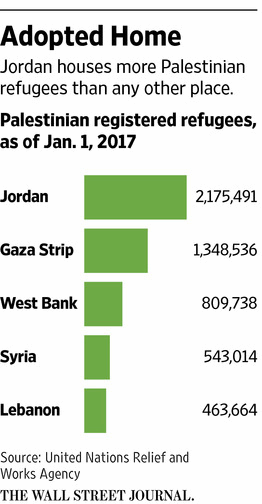 |
|
Source: Wall Street Journal and UNRWA. |
Water Scarcity and Israeli-Jordanian-Palestinian Water Deal
Jordan is among the most water-poor nations in the world and ranks among the top 10 countries with the lowest rate of renewable freshwater per capita.30 According to the Jordan Water Project at Stanford University, Jordan's increase in water scarcity over the last 60 years is attributable to an approximate 5.5-fold population increase since 1962, a decrease in the flow of the Yarmouk River due to the building of dams upstream in Syria, gradual declines in rainfall by an average of 0.4 mm/year since 1995, and depleting groundwater resources due to overuse.31
To secure new sources of freshwater, Jordan has pursued water cooperative projects with its neighbors. On December 9, 2013, Israel, Jordan, and the Palestinian Authority signed a regional water agreement (officially known as the Memorandum of Understanding on the Red-Dead Sea Conveyance Project, see Figure 6) to pave the way for the Red-Dead Canal, a multibillion-dollar project to address declining water levels in the Dead Sea. The agreement was essentially a commitment to a water swap, whereby half of the water pumped from the Red Sea is to be desalinated in a plant to be constructed in Aqaba, Jordan. Some of this water is to then be used in southern Jordan. The rest is to be sold to Israel for use in the Negev Desert. In return, Israel is to sell fresh water from the Sea of Galilee to northern Jordan and sell the Palestinian Authority discounted fresh water produced by existing Israeli desalination plants on the Mediterranean. The other half of the water pumped from the Red Sea (or possibly the leftover brine from desalination) is to be channeled to the Dead Sea. The exact allocations of swapped water were not part of the 2013 MOU and were left to future negotiations.
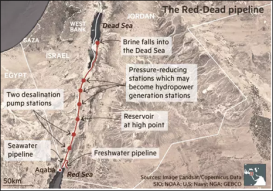 |
|
Source: Financial Times, March 22, 2017. |
In 2017, with Trump Administration officials seemingly committed to reviving the moribund Israeli-Palestinian peace process, U.S. officials focused on finalizing the terms of the 2013 MOU. In July 2017, the White House announced that U.S. Special Representative for International Negotiations Jason Greenblatt had "successfully supported the Israeli and Palestinian efforts to bridge the gaps and reach an agreement," with the Israeli government agreeing to sell the Palestinian Authority (PA) 32 million cubic meters (MCM) of fresh water.32
However, one recent report indicates that some Israeli officials may have misgivings about the project and are seeking to pull out of the deal.33 According to one unnamed U.S. official cited by the report, "The United States told Israel that the U.S. supports the project and expects Israel to live up to its obligations under the Red-Dead agreement or find a suitable alternative that is acceptable to Israel and Jordan."34
Congress has supported the Red-Dead Sea Conveyance Project. P.L. 114-113, the FY2016 Omnibus Appropriations Act, specifies that $100 million in Economic Support Funds be set aside for water sector support for Jordan, to support the Red Sea-Dead Sea water project. In September 2016, USAID notified Congress that it intended to spend the $100 million in FY2016 ESF-OCO on Phase One of the project.35
U.S. Foreign Assistance to Jordan
The United States has provided economic and military aid to Jordan since 1951 and 1957, respectively. Total bilateral U.S. aid (overseen by State and the Department of Defense) to Jordan through FY2016 amounted to approximately $19.2 billion. Jordan also has received hundreds of millions in additional military aid since FY2014 channeled through the Defense Department's various security assistance accounts.
Table 1. U.S. Foreign Assistance to Jordan, SFOPS Appropriations: FY2014-FY2019 Request
current dollars in millions
|
Account |
FY2014 |
FY2015 |
FY2016 |
FY2017 |
FY2018 est. |
FY2019 Request |
|
ESF |
$700.000 |
$615.000 |
$812.350 |
$832.350 |
$1,082.400 |
$910.800 |
|
FMF |
$300.000 |
$385.000 |
$450.000 |
$470.000 |
$425.000 |
$350.000 |
|
NADR |
$7.000 |
$7.700 |
$8.850 |
$13.600 |
$13.600 |
— |
|
IMET |
$3.500 |
$3.800 |
$3.733 |
$3.879 |
$4.000 |
$3.800 |
|
Total |
$1,010.500 |
$1,011.500 |
$1,274.933 |
$1,319.830 |
$1,525.000 |
$1,264.600 |
Source: U.S. State Department.
Notes: Funding levels in this table include both enduring (base) and Overseas Contingency Operation (OCO) funds. The Department of Defense also has provided Jordan with military assistance. According to the Department of State, "Jordan is the third largest recipient of FMF funds globally and the single largest recipient of DoD Section 333 funding."
New U.S.-Jordanian Agreement on Foreign Assistance
|
Figure 7. New U.S.-Jordanian MOU Amman, Jordan |
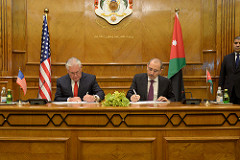 |
|
Source: U.S. State Department. |
On February 14, 2018, then-U.S. Secretary of State Rex W. Tillerson and Jordanian Minister of Foreign Affairs Ayman Safadi signed a new Memorandum of Understanding (or MOU) on U.S. foreign assistance to Jordan (Figure 7). The MOU, the third such agreement between the United and Jordan, commits the United States to provide $1.275 billion per year in bilateral foreign assistance over a five-year period for a total of $6.375 billion (FY2018-FY2022). This latest MOU represents a 27% increase in the U.S. commitment to Jordan above the previous iteration and is the first five-year MOU with the kingdom. The previous two MOU agreements had been in effect for three years. According to the U.S. State Department, the United States is the single largest donor of assistance to Jordan, and the new MOU commits the United States to provide a minimum of $750 million of Economic Support Funds (ESF) and $350 million of Foreign Military Financing (FMF) to Jordan between FY2018 and FY2022.36 In line with the new MOU, for FY2019 President Trump is requesting $1.271 billion for Jordan, including $910.8 million in ESF, $350 million in FMF, and $3.8 million in International Military Education and Training (IMET).
Economic Assistance
The United States provides economic aid to Jordan both as a cash transfer and for USAID programs in Jordan. The Jordanian government uses cash transfers to service its foreign debt. Approximately 40% to 60% of Jordan's ESF allotment may go toward the cash transfer.37 USAID programs in Jordan focus on a variety of sectors including democracy assistance, water preservation, and education (particularly building and renovating public schools). In the democracy sector, U.S. assistance has supported capacity-building programs for the parliament's support offices, the Jordanian Judicial Council, the Judicial Institute, and the Ministry of Justice.
The International Republican Institute and the National Democratic Institute also have received U.S. grants to train, among other groups, the Jordanian Independent Election Commission (IEC), Jordanian political parties, and members of parliament. In the water sector, the bulk of U.S. economic assistance is devoted to optimizing the management of scarce water resources, as Jordan is one of the most water-deprived countries in the world. USAID is currently subsidizing several waste treatment and water distribution projects in the Jordanian cities of Amman, Mafraq, Aqaba, and Irbid. USAID also is helping Jordanian water utilities on advanced leak detection capability.38
Humanitarian Assistance for Syrian Refugees in Jordan
The U.S. State Department estimates that, since large-scale U.S. aid to Syrian refugees began in FY2012, it has allocated more than $1.1 billion in humanitarian assistance from global accounts for programs in Jordan to meet the needs of Syrian refugees and, indirectly, to ease the burden on Jordan.39 U.S. aid supports refugees living in camps (~141,000) and those living in towns and cities (~500,000). According to the State Department, U.S. humanitarian assistance is provided both as cash assistance and through programs to meet basic needs, such as child health care, water, and sanitation.
The U.S. government provides cross-border humanitarian and stabilization assistance to Syrians via programs monitored and implemented through the Embassy Amman-based Southern Syria Assistance Platform. This includes humanitarian assistance to areas of southern and eastern Syria that are otherwise inaccessible, as well as congressionally authorized stabilization and nonlethal assistance to opposition-held areas in southern Syria. According to USAID, U.S. humanitarian assistance funds are enabling UNICEF to provide health assistance for Syrian populations sheltering at the informal Rukban and Hadalat settlements along the Syria-Jordan border berm, including daily water trucking, the rehabilitation of a water borehole, and installation of a water treatment unit in Hadalat.40
Loan Guarantees
The Obama Administration provided three loan guarantees to Jordan, totaling $3.75 billion.41 These include the following:
- In September 2013, the United States announced that it was providing its first-ever loan guarantee to the Kingdom of Jordan. USAID notified Congress of its intent to obligate up to $120 million in FY2013 ESF-OCO to support a $1.25 billion, seven-year sovereign loan guarantee for Jordan.
- In February 2014, during a visit to the United States by King Abdullah II, the Obama Administration announced that it would offer Jordan an additional five-year, $1 billion loan guarantee. USAID notified Congress of its intent to obligate $72 million out of the $340 million of FY2014 ESF-OCO for Jordan to support the subsidy costs for the second loan guarantee.
- In June 2015, the Obama Administration provided its third loan guarantee to Jordan of $1.5 billion. USAID notified Congress of its intent to obligate $221 million in FY2015 ESF to support the subsidy costs of the third loan guarantee to Jordan.42
Military Assistance
Foreign Military Financing
U.S.-Jordanian military cooperation is a key component in bilateral relations. U.S. military assistance is primarily directed toward enabling the Jordanian military to procure and maintain conventional weapons systems.43 The United States and Jordan have jointly developed a five-year procurement plan for the Jordanian Armed Forces in order to prioritize Jordan's needs and procurement budget using congressionally appropriated Foreign Military Financing (FMF). FMF grants have enabled the Royal Jordanian Air Force to procure munitions for its F-16 fighter aircraft and a fleet of 28 UH-60 Blackhawk helicopters.44 On February 18, 2016, President Obama signed the United States-Jordan Defense Cooperation Act of 2015 (P.L. 114-123), which authorizes expedited review and an increased value threshold for proposed arms sales to Jordan for a period of three years.
Defense Department Assistance
As a result of the Syrian civil war and Operation Inherent Resolve against IS, the United States has increased military aid to Jordan and channeled these increases through Defense Department-managed accounts. Although Jordan still receives the bulk of U.S. military aid from the FMF account, Congress has authorized defense appropriations to strengthen Jordan's border security. Jordan may receive funding from various DOD accounts, such as the following:
- 10 U.S.C. 333—Commonly referred to as DOD's "Global Train and Equip authority." The Secretary of Defense may use this to build the capacity of a foreign country's national security forces for a range of purposes, including counterterrorism, countering weapons of mass destruction, counternarcotics, maritime security, military intelligence, and participation in coalition operations.45
- Counterterrorism Partnerships Fund (CTPF) (FY2015-FY2016)—Under the FY2015 NDAA (P.L. 113-291) and the defense appropriations measure for the same year (P.L. 113-235), Congress established a DOD Counterterrorism Partnerships Fund (CTPF), which provided increased funding resources for counterterrorism training and equipment transfers in Africa and the Middle East.46 Section 1534 of FY2015 NDAA stipulated that funds could be transferred to other accounts for use under existing DOD authority established by "any other provision of law." The FY2017 NDAA (P.L. 114-328) expanded and consolidated DOD's "global train and equip" authority, along with various others, under Section 333 of a new Chapter 16 of Title 10, U.S.C (see above). Since then, Congress has not appropriated funds for DOD's CTPF, instead directing funds under DOD's Operation and Maintenance, Defense-Wide account for a range of security cooperation activities.
- Coalition Support Fund (CSF)—CSF authorizes the Secretary of Defense to reimburse key cooperating countries for logistical, military, and other support, including access, to or in connection with U.S. military operations in Iraq, Afghanistan, or Syria and to assist such nations with U.S.-funded equipment, supplies, and training. CSF is authorized by Section 1233 (FY2008 NDAA, P.L. 110-181), as amended and extended.
- Counter-ISIS Train and Equip Fund (CTEF)—The National Defense Authorization Act for Fiscal Year 2017 (P.L. 114-328) and The Consolidated Appropriations Act, 2017 (P.L. 115-31) created the Counter-ISIL Train and Equip Fund (CTEF), since renamed the Counter-ISIS Train and Equip Fund. The CTEF is designed to allow the Secretary of Defense, with the concurrence of the Secretary of State, to transfer funds, equipment, and related capabilities to partner countries in order to counter emergent ISIS threats. The CTEF is the primary account for the Syria and Iraq Train and Equip Programs.47 It replaced the Iraq Train and Equip Fund (ITEF).
- Cooperative Threat Reduction—DOD is authorized, under Chapter 48 of Title 10, U.S.C., to build foreign countries' capacity to prevent nuclear proliferation. Over the past five years, the Defense Threat Reduction Agency has provided training and equipment to border security forces in several Middle Eastern countries under this authority, including Jordan, Iraq, Turkey, and Tunisia.48
Excess Defense Articles
In 1996, the United States granted Jordan Major Non-NATO Ally (MNNA) status, a designation that, among other things, makes Jordan eligible to receive excess U.S. defense articles, training, and loans of equipment for cooperative research and development.49 In the last five years, Jordan has received excess U.S. defense articles, including two C-130 aircraft, HAWK MEI-23E missiles, and cargo trucks.
Recent Legislation
P.L. 115-14, the Consolidated Appropriations Act, 2018, provided the following for Jordan:
- Appropriates "not less than" $1.525 billion in total U.S. assistance for Jordan, of which "not less than" $1.082 billion is ESF and "not less than" $425 million is FMF;
- Reauthorizes funds from the Operation and Maintenance, Defense-Wide account to "enhance the ability of the armed forces of Jordan to increase or sustain security along its borders";
- Appropriates "up to" $500 million for the Defense Security Cooperation Agency in the Operation and Maintenance, Defense-Wide account to be used to support the armed forces of Jordan and to enhance security along its borders;
- Reauthorizes funds from the Counter-ISIS Train And Equip Fund (CTEF) to enhance the border security of nations adjacent to conflict areas including Jordan, Lebanon, Egypt, and Tunisia resulting from actions of the Islamic State of Iraq and Syria;
- Reauthorizes ESF to be used to support possible new loan guarantees for Jordan;
- Authorizes ESF to be used to support the creation of an Enterprise Fund in Jordan.
P.L. 115-245, the Department of Defense and Labor, Health and Human Services, and Education Appropriations Act, 2019 and Continuing Appropriations Act, 2019, provides the following for Jordan:
- Reauthorizes funds from the Operation and Maintenance, Defense-Wide account to "enhance the ability of the armed forces of Jordan to increase or sustain security along its borders";
- Appropriates "up to" $500 million for the Defense Security Cooperation Agency in the Operation and Maintenance, Defense-Wide account to be used to support the armed forces of Jordan and to enhance security along its borders;
- Reauthorizes funds from the Counter-ISIS Train And Equip Fund (CTEF) to enhance the border security of nations adjacent to conflict areas including Jordan, Lebanon, Egypt, and Tunisia resulting from actions of the Islamic State of Iraq and Syria.
H.R. 2646, United States-Jordan Defense Cooperation Extension Act, would amend the United States-Jordan Defense Cooperation Act of 2015 to extend Jordan's inclusion among the countries eligible for certain streamlined defense sales until December 31, 2022. The bill also would authorize an enterprise fund to provide assistance to Jordan. It was passed in the House on February 5, 2018.
|
Account |
1946-2011 |
FY2012 |
FY2013 |
FY2014 |
FY2015 |
FY2016 |
1946-2016 |
|
FMF |
3,380.800 |
300.000 |
284.800 |
300.000 |
385.000 |
450.000 |
5,100.600 |
|
ESF |
6,043.800 |
485.500 |
542.900 |
329.600 |
594.700 |
812.350 |
8,808.850 |
|
INCLE |
3.800 |
1.200 |
— |
0.800 |
0.200 |
— |
6.000 |
|
NADR |
110.600 |
18.400 |
12.200 |
6.100 |
5.400 |
8.850 |
166.300 |
|
IMET |
70.700 |
3.700 |
3.600 |
3.600 |
3.800 |
3.733 |
89.400 |
|
MRA |
82.100 |
35.200 |
167.100 |
157.600 |
162.500 |
tbd |
604.500 |
|
Other |
2,963.500 |
330.100 |
199.400 |
345.700 |
365.400 |
322.930 |
4,527.030 |
|
Total |
12,655.300 |
1,174.100 |
1,210.000 |
1,143.400 |
1,517.000 |
1,597.863 |
19,297.663 |
Source: USAID Overseas Loans and Grants, July 1, 1945-September 30, 2015.
Notes: "Other" accounts include economic and military assistance programs administered by USAID, State, and other federal agencies which are funded at less than $2 million annually. It also includes larger, more recent funding through the International Disaster Assistance account (IDA), Millennium Challenge Account, and several defense department funding accounts. It also encapsulates much larger legacy programs (food aid), some of which have been phased out over time.